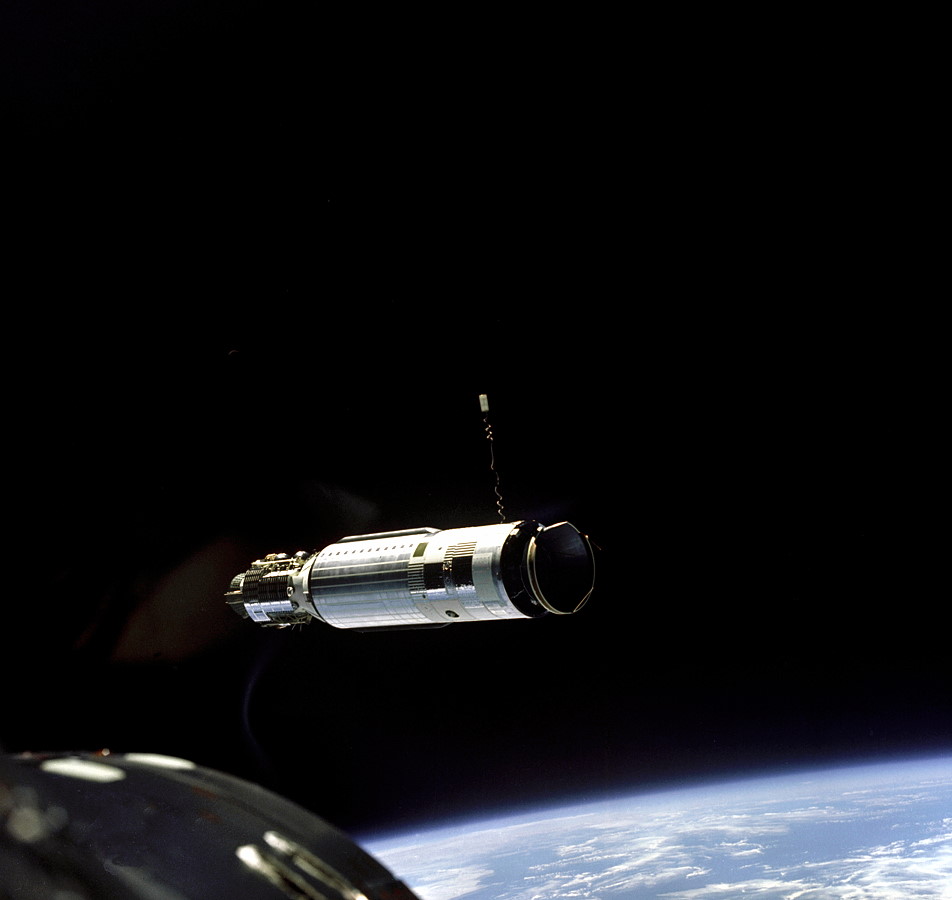
Spring 1966 was a period of gloom for America’s space program. Two astronauts-in-training had been killed on 28 February in an aircraft crash, just 500 feet (150 meters) from the building in which their spacecraft was being built, whilst the crew of Gemini VIII—future Moonwalkers Neil Armstrong and Dave Scott—came close to losing their own lives on 16 March, when their ship encountered violent oscillations after performing the first successful in-space docking. With the deaths of original Gemini IX crewmen Elliot See and Charlie Bassett, their backups, Tom Stafford and Gene Cernan, were reassigned as the new prime crew. But theirs would turn into a mission of frustration. This frustration was prefaced, 50 years ago, this week, by the loss of the single most important element of their mission: the Gemini-Agena Target Vehicle (GATV), their rendezvous and docking target.
Since the dawn of Project Gemini—the series of missions intended to demonstrate key techniques and technologies, including rendezvous and docking, ahead of the Apollo lunar voyages—the pencil-like Agena had played a pivotal role. Launched atop an Atlas booster from Pad 14 at Cape Kennedy, it would provide a rendezvous target for Gemini VI and later for the final five missions of the series, Gemini VIII through XII. An initial GATV (code numbered “5001”) arrived at the Cape in May 1965, as a non-flying test article, with “5002” arriving in August as the first flight-ready vehicle. Unfortunately, 5002 was lost in a launch mishap in October 1965, which led NASA to use the long-duration “solo” Gemini VII spacecraft alongside Gemini VI in December as a new rendezvous target.
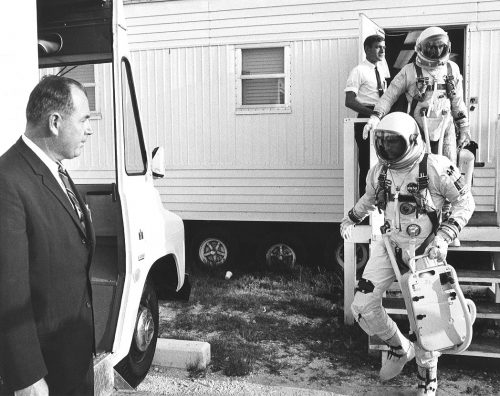
Three months later, another GATV (“5003”) was met in space by Armstrong and Scott aboard Gemini VIII, who performed a successful rendezvous and docking, but were forced to abort their mission when they suffered near-uncontrollable oscillations. Fortunately, the astronauts’ quick reactions allowed investigators to zero-in on the cause of the oscillations, which ultimately placed the blame on a stuck-on thruster aboard Gemini VIII and exonerated the GATV. This avoided a lengthy delay, and Gemini IX and its GATV (“5004”) were scheduled to fly on 17 May 1966. Stafford and Cernan’s three days in space were described by NASA as “really exciting” and were expected to generate “experience one would not ordinarily expect to get in less than three missions.” In addition to a lengthy EVA by Cernan, the crew would utilize the GATV to simulate how an Apollo Command and Service Module (CSM) would rendezvous and dock with a Lunar Module (LM). Stafford and Cernan would also fire the Agena’s main engine to boost themselves into a higher orbit.
Capable of restarting its engine in orbit, the 20.7-foot-long (6.3-meter) vehicle had been named for the extremely bright, 0.61-magnitude star Beta Centauri (traditionally known as “Agena”), because it would “ignite in the sky.” In fact, the GATV’s Bell Model 8247 engine—also known by its Air Force nomenclature of “XLR81-BA-13”—was designed to fire on up to 15 occasions, via radio command, delivering a thrust of 16,000 pounds (7,260 kg). As circumstances transpired, it was never fired that many times, peaking at eight “burns” during Gemini XI in September 1966, but on that particular flight it succeeded in achieving the highest altitude ever attained by a human crew at that time. In fact, the Gemini XI peak apogee of 854 miles (1,375 km) still stands to this day as the highest altitude ever attained by astronauts on a non-lunar voyage.
By the end of March 1966, Stafford and Cernan’s Gemini IX spacecraft—mounted atop a Titan II booster—was erected at the Cape’s Pad 19. Elsewhere, the Atlas booster was at Pad 14 and, early in May, the Agena (tail-numbered “5004”) arrived at the launch complex and was installed. In the wee hours of 17 May, Flight Director Gene Kranz arrived at his console in the Mission Operations Control Room (MOCR) at the Manned Spacecraft Center (MSC) in Houston, Texas, to oversee both the launches of the 5004 GATV and, about 99 minutes later, of Stafford and Cernan aboard Gemini IX. “Only 200 newsmen were on hand, compared to the thousand or more who had covered Gemini IV the year before,” noted Barton C. Hacker and James M. Grimwood in their definitive history of the program, On the Shoulders of Titans. “Gemini was becoming more routine, hence less newsworthy.”
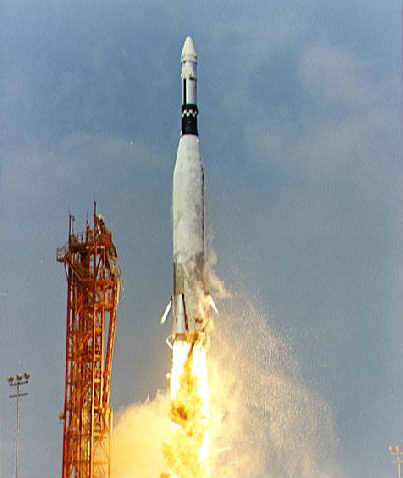
In the crew quarters of Cape Kennedy, the prime crew was awakened and underwent standard medical checks, before sitting down to breakfast with Chief Astronaut Al Shepard and Deke Slayton, the head of the Flight Crew Operations Directorate (FCOD). In his autobiography, The Last Man on the Moon, Cernan recounted keeping “a stone face, all business, but butterflies stirred in my stomach.” Around his neck, the 32-year-old Navy lieutenant-commander strung a small medal, bearing a silver disk with the image of Our Lady of Loreto. This was accompanied by the legend: “Patroness of Aviation, Pray for Me.” In Catholic tradition, the house in which the Virgin Mary was born was later transported by angels from the Holy Land to Dalmatia and thence to Loreto, Italy. This “flight,” it is said, laid the foundations for the Lady of Loreto’s patronage of aviators.
Alongside Stafford, Cernan then settled into a couch to have his biosensors and space suit fitted. Their heightened sense of anxiety was not aided when Slayton took Stafford aside for a few moments. Not until much later would Cernan discover the topic of their private conversation. It was a conversation that Slayton would have with other Gemini command pilots with a mission that featured an EVA: If anything went wrong and the spacewalker was unable to get back inside the cabin, NASA could ill-afford to have a dead astronaut abandoned in space. Somehow, if the worst happened, Stafford would have to bring Cernan’s corpse back to Earth.
In his own autobiography, We Have Capture, Stafford remembered staring at Slayton in astonishment. “To bring him back,” he wrote, “the hatch is going to be left partially open because the attachment point for the umbilical is inside the spacecraft near the attitude hand controller.” Such an awkward re-entry would not be survivable. In reality, he told Slayton, when the explosive bolts blew at the base of the Titan II booster, signaling liftoff, it was Stafford, as Gemini IX’s command pilot, who would call the shots and make the difficult decisions if something should go wrong.
Cernan also knew that the only realistic option for Stafford would be to cut him loose, close the hatch, and return to Earth alone. “I knew Tom would be unable to pull me back inside if I couldn’t get myself out of trouble,” he wrote. “He would work like the devil to rescue me, but eventually would have to abandon me. We both knew it.”
Slayton would have a similar conversation a few weeks later with Gemini X’s command pilot, John Young, and would receive a similar reception. “There was no way,” Young recounted later, “if anything happened to somebody going outside a Gemini that you could get them back in.” The seat was too narrow and it was impossible for the command pilot to reach over and pull an inflated, rigidized space suit—with an immobile person inside—back into the right-hand seat with enough overhead clearance to close the hatch.
It is more than fortunate, therefore, that such an eventuality never came to pass.
However, such thoughts were extinguished on the morning of 17 May 1966, as an altogether different contingency suddenly engulfed Gemini IX.
The second part of this article will appear tomorrow.
Want to keep up-to-date with all things space? Be sure to “Like” AmericaSpace on Facebook and follow us on Twitter: @AmericaSpace




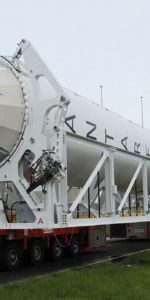
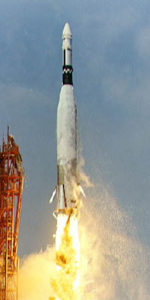
I remember hearing this from a Video that had Tom Stafford recall that conversation, and it sent a chill up my spine. Imagine..Well why didn’t NASA have a better Plan B? C? instead of a Last minute Oh by the way….. Thanks for this story Ben.